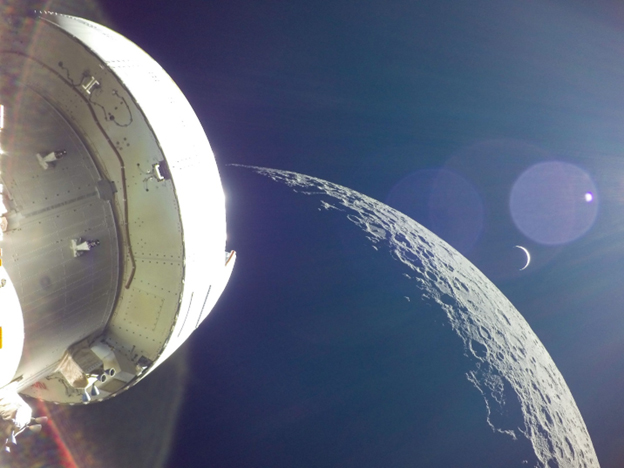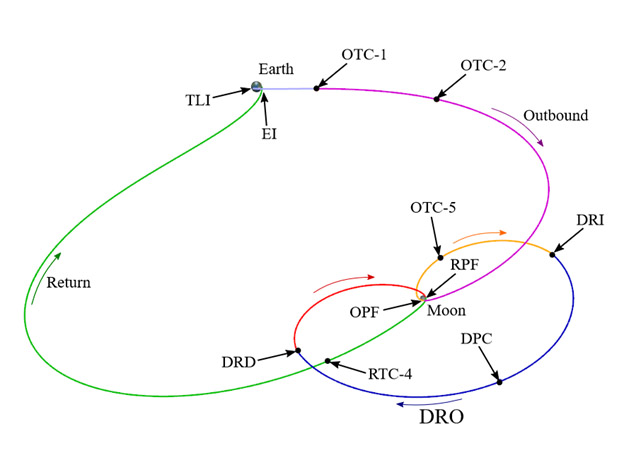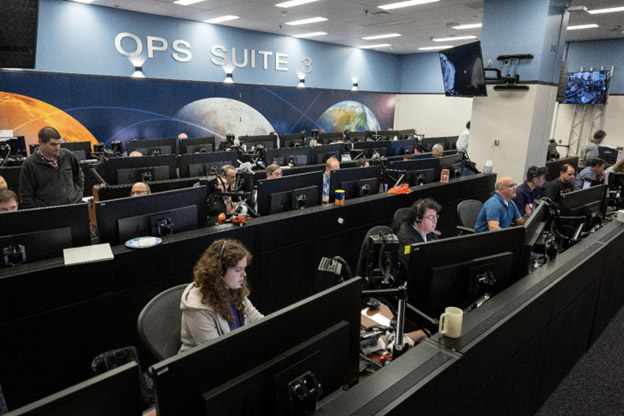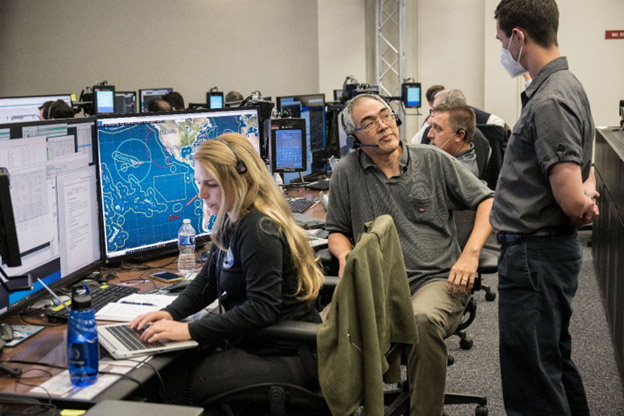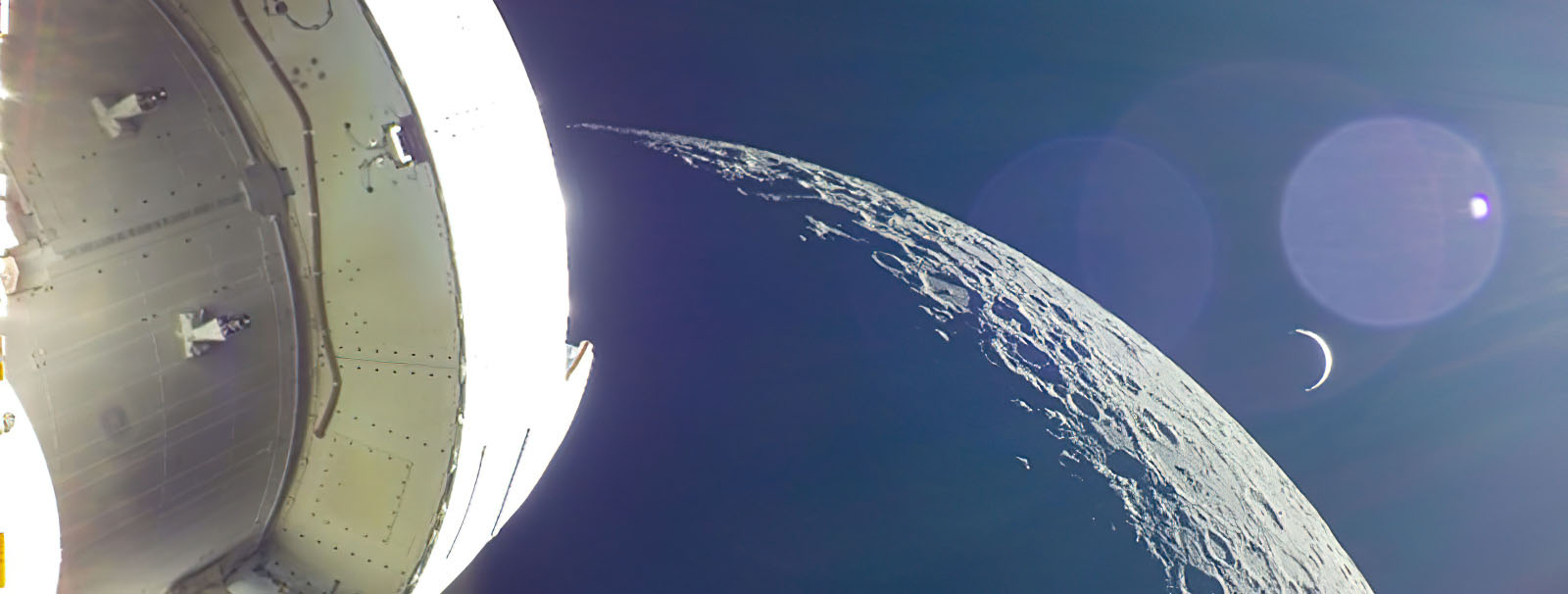
Flybys, Launch Windows, and Selfies with the Earth and Moon: The Artemis I Flight from the Perspective of a Member of the Trajectory-Design Team By Robert E. Harpold
Trajectory Design Our team designed the trajectories, the path the spacecraft would take from the Earth to the Moon and back again. In order to prove the Orion spacecraft could carry humans, the trajectory had to satisfy several mission objectives, including testing the heat shield at lunar-return velocities, demonstrating that Orion’s propulsion, navigation, communications, and other systems could operate in the space environment, and returning the vehicle to a designated landing site. Jacob Williams designed the original trajectory over a decade ago. Orion’s destination was a Distant Retrograde Orbit (DRO) around the Moon, an interesting orbit where the spacecraft is actually in Earth orbit, but, from the perspective of an observer on the Moon, it would look like the spacecraft was orbiting the Moon backward. In the nominal mission plan, five major burns would be performed (Figure 2). Ninety minutes after launch, the Interim Cryogenic Propulsion Stage (ICPS) would perform the Trans-Lunar Injection (TLI) burn to send Orion to the Moon. During the flyby of the Moon, Orion would perform the Outbound Powered Flyby (OPF) burn which, with the assistance of the Moon’s gravity, would send Orion on a path toward the DRO. It would then perform the Distant Retrograde orbit Insertion (DRI) burn to enter the DRO. Six days later, it would perform the Distant Retrograde orbit Departure (DRD) burn to head back to the Moon, and then perform the Return Powered Flyby (RPF) burn to use the Moon’s gravity to return to Earth. Tim Dawn updated the original trajectory to account for additional mission constraints. One of those constraints was making certain Orion’s landing occurred during daylight, which would help recovery operations. To achieve this objective, the mission duration could be between 26 – 28 days or 38 – 42 days. Max Widner wrote software that would select the mission duration that achieved all mission objectives and minimized fuel usage.
In addition, Jeff Gutkowski was our team lead, Randy Eckman wrote trajectory-design tools, Amelia Batcha was our main analyst studying the feasibility of each trajectory, Badejo Adebonojo ran the missed-burn cases, Elizabeth Williams wrote software to plot different data for each trajectory, Josh Geiser joined our team shortly before launch, and Matt Horstman and Jacob generated off-nominal trajectories in the office after launch. Most of us worked on future Artemis missions at the same time, but I am only listing the tasks we performed specifically for Artemis I. Our team had fun with the tool names. There was Damocles, an ominous name that raised some eyebrows. That name inspired Elizabeth to call her plotting tool Plotacles. We also had a trajectory vending machine, RoboCopPy, and RATGATOR. Similarly, one of the teams in Mission Control named all their tools after Batman characters. Every month until we launched, our team cranked out all the necessary trajectories (nominal and off-nominal) and presented them to management and our flight controller counterparts. This work was in addition to our development of new contingency options we kept realizing we needed, which continued up to the day we launched. Because of our trajectory work, the flight controllers in Mission Control needed our team to be on console in the Mission Evaluation Room. MER and TARGO Most people have heard of Mission Control in Houston. It’s the room where the Flight Director and the flight controllers, each in charge of their own specialty, help operate the spacecraft and troubleshoot any anomalies during flight. Each flight controller is supported by a counterpart in a back room (called the Multi-Purpose Support Room or MPSR, pronounced ‘mip-ser’) with whom they are in constant contact. Where a flight controller is in charge of integrating their system with the entire team, the people in the MPSR focus on work related to their specific subsystem. There is also a back backroom called the MER (Mission Evaluation Room, pronounced ‘mer’) for the people who designed, built, and/or tested the subsystems. They monitor their systems and help the flight controllers troubleshoot anomalies. For an Apollo 13 analogy, there was a time where NASA engineers had to figure out how to fit the command module’s square carbon-dioxide-filter canister into the round slot for the lunar module’s canister. That problem is an extreme example of the kind of work the MER would be called upon to do. There were twenty consoles in the MER (Figure 3), and at any given time, there were about thirty people in the room. Our team’s console in the MER was called TARGO (Trajectory Analysis, RetarGeting, and Optimization). We primarily supported the Flight Dynamics Officer (FDO, pronounced like the dog name), the Mission Control console in charge of the spacecraft trajectory. The FDOs have been treated with high respect since the early days of human spaceflight, and, from my experience interacting with them, they deserve every bit of that respect. During flight, we provided them with updated nominal trajectories and off-nominal options for each phase of the mission, as well as performing additional analysis when requested.
The Flight After so many delays, it felt surrealistic to watch Artemis I launch on November 16. I woke up my wife, Julie, and 13-month-old daughter, Isabelle, to watch the SLS rocket take off at 00:47:44 Central Time. Tim and Brian were on console for our team, Randy and Sarah were getting ready to take over from them two hours after launch, and Colin and I were going to take the third shift several hours later. I should have been asleep, but I didn’t want to miss the historic launch, and I also wanted to find out what kind of day I was going to have. The SLS performed perfectly, and the TLI was perfect, so I was able to go to sleep with a positive feeling. We supported the flight 24/7, with day, swing, and night shifts. Our team rotated through shifts, so no one was on any one shift the whole time (although Max had a lot of night shifts). Typically, two TARGOs were on console at a time, a prime and a second to help with the workload. We also rotated being prime and second. It was a rough schedule, particularly the first two-thirds of the mission where we not only supported on console, but spent time off-console cranking out off-nominal options for each mission phase based on the most up-to-date trajectory information. So it was exhausting and a lot of work, but also fun and exciting. I loved getting to be in such a great seat to see this historic mission taking place and to be among so many hardworking and passionate experts who had dedicated so much of themselves to sending humans beyond low Earth orbit again. Even when I was sleep-deprived and waking up at odd hours, I was happy being in a place and time where I could do what I had dreamed about doing since I was nine years old. I’m sure many of the people there felt the same.
Throughout the shift, the Moon kept getting larger and larger on the screen. Amelia joined us later to help with some of the work. The FDO and his backroom counterpart were setting up the spacecraft commands to perform the burn. Since the burn would be performed behind the Moon, we would lose contact for twenty minutes and wouldn’t know if the burn was successful until the spacecraft reappeared from the other side. If the burn failed, we would regain contact with the spacecraft two minutes earlier. Both countdowns were displayed on the MER screens. Up to the moment Orion went behind the Moon, everyone was checking their systems. The MER Manager announced we would have a go/no-go poll in a few minutes. It took me a second to realize what that meant, and I said it out loud to Max and Amelia: “Oh, wow, I get to be the one who says, ‘Go!’” When it came time for the poll, the MER Manager called, “TARGO?” I said, “Go!” maybe a little more forcefully than necessary. A few seconds later, the MER Manager repeated the question, and I realized I had spoken on the wrong loop. Even after all the training. I switched to the correct loop and said it again, with most of the enthusiasm of the first time. On the screens, we could see Earth as a small blue ball. As the spacecraft got closer to passing behind the Moon, Earth moved closer and closer to the horizon. The final image before we lost contact showed the marble-sized Earth just above the Moon’s horizon. Once the spacecraft was out of contact, there was nothing we could do. People stood and started talking, and the atmosphere became festive. We’d gotten to the Moon! And Orion had taken some cool selfies with the Earth and Moon! It was also a good time for restroom breaks. The MER Manager quieted us down two minutes before the first countdown, the one we didn’t want to see, where the spacecraft would arrive early if it missed the burn. That time came and went, and everyone felt relieved. Then, right on time, on the screens, we saw the Earthrise. Since the side of the Moon closest to Orion was unlit at that point, the view looked like Earth floating by itself in darkness. It was proof that OPF had been performed correctly, and that Orion was headed to the correct orbit. Everyone in the room clapped. We remained busy for several days, performing three other major burns. After the RPF, Orion was locked on course toward its landing site on Earth, so there wasn’t much the TARGOs could do. We kept supporting up to the shift before splashdown, doing occasional analysis and answering questions from other MER people. I watched the splashdown from home. It was great seeing everything happen just as planned: the command and service modules separating, the spacecraft entering the atmosphere, the parachutes deploying, and the spacecraft landing in the water. After so many years, we had sent a human-rated spacecraft to the Moon, and it had performed extraordinarily well. Next time, we’re sending people there. |
 |
DreamForge Anvil © 2023 DreamForge Press
Flybys, Launch Windows, and Selfies with the Earth and Moon: The Artemis I Flight from the Perspective of a Member of the Trajectory-Design Team © 2023 Robert E. Harpold
